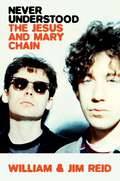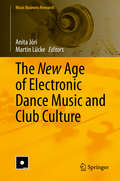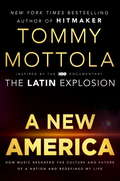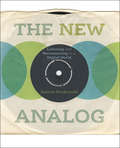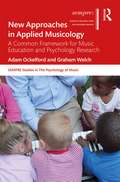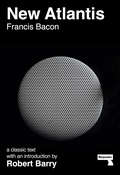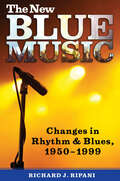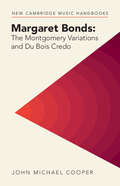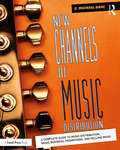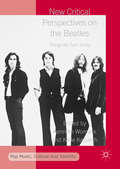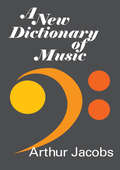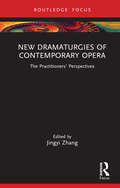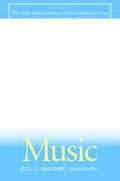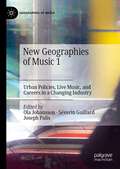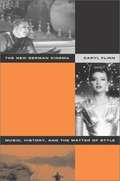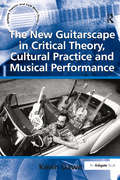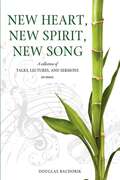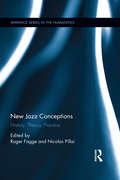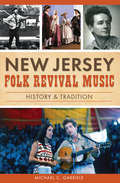- Table View
- List View
Never Understood: The Jesus and Mary Chain
by William Reid Jim ReidWilliam and Jim Reid, brothers and founding members of The Jesus and Mary Chain—a band that bridged the gap between the punk explosion and the emergence of grunge and Britpop—chronicle the chaos, confusion, and stories behind their music. For five years after they&’d swapped sought-after apprenticeships for life on the dole, brothers William and Jim Reid sat up till the early hours in the front room of their parents&’ East Kilbride council house, plotting their path to world domination over endless cups of tea, with the music turned down low so as not to wake their sleeping sister. They knew they couldn&’t play in the same band because they&’d argue too much, so they&’d describe their dream ensembles to each other until finally they realized that these two perfect bands were actually the same band. The name of that band was The Jesus and Mary Chain. The rest was not silence, and picking up those conversations again more than forty years later, William and Jim tell the full story of one of Britain&’s greatest guitar bands for the very first time – a wildly funny and improbably moving chronicle of brotherly strife, feedback, riots, drug and alcohol addiction, eternal outsiders and extreme shyness, that also somehow manages to be a love letter to the Scottish working-class family.
The New Age of Electronic Dance Music and Club Culture (Music Business Research)
by Martin Lücke Anita JóriThis book offers a comprehensive overview of electronic dance music (EDM) and club culture. To do so, it interlinks a broad range of disciplines, revealing their (at times vastly) differing standpoints on the same subject. Scholars from such diverse fields as cultural studies, economics, linguistics, media studies, musicology, philosophy, and sociology share their perspectives. In addition, the book features articles by practitioners who have been active on the EDM scene for many years and discuss issues like gender and diversity problems in general, and the effects of gentrification on club culture in Berlin. Although the book’s main focus is on Berlin, one of the key centers of EDM and club culture, its findings can also be applied to other hotspots. Though primarily intended for researchers and students, the book will benefit all readers interested in obtaining an interdisciplinary overview of research on electronic dance music.
A New America: How Music Reshaped the Culture and Future of a Nation and Redefined My Life
by Tommy MottolaThe long-anticipated companion book to the groundbreaking HBO documentary The Latin Explosion by renowned music producer Tommy Mottola. Legendary music mogul, entertainment impresario, and New York Times bestselling author Tommy Mottola explores and expounds on his lifelong love of Latin music, its influence on his life and career, and its ever-growing influence in America. Tommy Mottola discovered a passion for Latin music when he was a small child on the streets of the Bronx, where he fell in love with the energy and rhythm of the legendary Tito Puente. It is a love he carries with him to this day. In A New America, Mottola explores the societal and cultural impact the Latino community and its music has had on America by sharing behind-the-scenes stories from his own life and his connection to the Latin sound throughout the decades--from his initial fascination with Latin music, which started with Puente, to the mainstream success of Ritchie Valens, to the groove-laden guitar wizardry of Carlos Santana. Along the way, Mottola reveals heartfelt accounts of his longtime collaboration and friendship with Gloria Estefan and her husband, Emilio, the meteoric rise and tragic end of Selena, and his orchestration of the Latin Explosion of the 1990s, which launched megastars such as Marc Anthony, Ricky Martin, Shakira, and Jennifer Lopez. But A New America is more than a story about music and musicians. It is the story of a culture that continues to grow and influence America in all its aspects and an irresistible sound that continues to move and inspire the nation.From the Hardcover edition.
The New Analog: Listening and Reconnecting in a Digital World
by Damon KrukowskiAn NPR Best Book of the Year: &“A pointedly passionate look at what&’s been lost in the digital era.&” —Los Angeles Times A longtime musician and former member of the indie band Galaxie 500 who has also taught at Harvard, Damon Krukowski has watched cultural life lurch from analog to digital. And as an artist who has weathered that transition, he has challenging, urgent questions for both creators and consumers about what we have thrown away in the process: Are our devices leaving us lost in our own headspace even as they pinpoint our location? Does the long reach of digital communication come at the sacrifice of our ability to gauge social distance? Does streaming media discourage us from listening closely? Are we hearing each other fully in this new environment? Rather than simply rejecting the digital disruption of cultural life, Krukowski uses the sound engineer&’s distinction of signal and noise to reexamine what we have lost as a technological culture, looking carefully at what was valuable in the analog realm so we can hold on to it. Taking a set of experiences from the production and consumption of music that have changed since the analog era—the disorientation of headphones, flattening of the voice, silence of media, loudness of mastering, and manipulation of time—as a basis for a broader exploration of contemporary culture, Krukowski gives us a brilliant meditation and guide to keeping our heads amid the digital flux. Think of it as plugging in without tuning out. &“This is not a book about why vinyl sounds better; it&’s way more interesting than that . . . [It] is full of things I didn&’t know, like why people yell into cellphones . . . Ultimately, it&’s about how we consume sound as a society—which is, increasingly, on an individual basis.&” —NPR &“If you&’re a devoted music fan who&’s dubious about both rosy nostalgia and futuristic utopianism, Damon Krukowski&’s The New Analog is for you.&” —The New York Times Book Review
A New and Concise History of Rock and R&B through the Early 1990s
by Eric CharryA New and Concise History provides a strong foundation for understanding how music, the music industry, and American culture intersect. Ethnomusicologist Eric Charry's innovative and road-tested teaching style is brought to you in this textbook suitable for general education courses in music. The book is organized around a series of timelines, tables, and figures created by the author, and provides fresh perspectives that bring readers into the heart of the social and cultural importance of the music. Charry lays out key contemporary theoretical issues, covers the technical foundations of the music industry, and provides a capsule history of who did what when, with particular emphasis on the rapid emergence of distinct genres and subgenres. The book's figures distill the history and provide new insight into understanding trends. Over 1000 artists, albums, and songs are included here, such as Muddy Waters, Elvis Presley, Bob Dylan, Aretha Franklin, the Velvet Underground, Janis Joplin, Jimi Hendrix, David Bowie, Stevie Wonder, Prince, Madonna, Talking Heads, and Public Enemy.
New Approaches in Applied Musicology: A Common Framework for Music Education and Psychology Research (SEMPRE Studies in The Psychology of Music)
by Adam Ockelford Graham WelchThis book presents four extended essays that are rooted in the growing interdisciplinary field of applied musicology, in which music theory – in particular, the zygonic conjecture – is used to inform thinking in the domains of music psychology, music education and music therapy research. It is essential reading for academics and postgraduate students working in these fields. The topics covered include a new study on the emergence of musical abilities in the early years, using the Sounds of Intent framework of musical development; an exploration of how the Sounds of Intent model can be extended to map how people with learning difficulties engage in creative multisensory activities; an investigation of the expectations generated on hearing a piece of music more than once evolve in cognition, using evidence from a musical savant; and a report on the effect on listeners of repeated exposure to a novel melody. Data are drawn from the findings of postgraduate and postdoctoral projects. It is hoped that this exciting new work will act as a catalyst in the emerging field of applied musicological research, and bring recognition to a group of new young academics.
New Atlantis and Selections from the Sylva Sylvarum
by Francis BaconFrancis Bacon's classic technological utopia brought to life for the modern sonic arts. In the early seventeenth century, at the very end of his life, the English statesman and philosopher Francis Bacon wrote a utopian fable called New Atlantis, containing an uncanny presentiment of twentieth-century electronic music. Now, four hundred years ago, music writer Robert Barry digs into the significance of that tale for the history of music, media, science and the senses. New Atlantis marked a significant turning point in the history of utopian literature -- not to mention the pre-history of science fiction, and even modern science itself. At the heart of the island paradise stumbled upon by Bacon's stranded sailors is a research institute called Bensalem where the locals practice "all sounds and their generation". The passage was sufficiently inspiring that Daphne Oram quoted it in full and pinned it to the wall of the newly opened BBC Radiophonic Workshop in 1957. Newly re-united with extracts from the Sylva Sylvarum, a notebook of real experiments that New Atlantis originally came bound with in the seventeenth century, this new publication seeks to bring Bacon's ideas to life for a new generation of artists and scholars engaged in the sonic arts, media archeology, and science studies. New Atlantis is presented with a brand new introduction by author and musician Robert Barry, which lays out the continuing relevance of Bacon's utopia for the place of sound and technology in the arts to this day.
New Bach Reader
by Hans T. David David Mendel Wolfe"Just reading these documents brings this great composer to life in a most exciting and vivid way. I love this book!" ―Yo-Yo Ma Through hundreds of letters, family papers, anecdotes, and records, the Bach Reader established a new approach to biography by offering original documents in impeccable translations. In The New Bach Reader, Christoph Wolff has incorporated numerous facsimiles and added many newly discovered items, reflecting the current state of scholarship about the composer's life and music. The readings in this volume provide an accurate and vivid picture of Bach's world and of his far-reaching influence.
The New Blue Music: Changes in Rhythm & Blues, 1950–1999 (American Made Music Series)
by Richard J. RipaniRhythm & blues emerged from the African American community in the late 1940s to become the driving force in American popular music over the next half-century. Although sometimes called “doo-wop,” “soul,” “funk,” “urban contemporary,” or “hip-hop,” R&B is actually an umbrella category that includes all of these styles and genres. It is in fact a modern-day incarnation of a musical tradition that stretches back to nineteenth-century America, and even further to African beginnings. The New Blue Music: Changes in Rhythm & Blues, 1950-1999 traces the development of R&B from 1950 to 1999 by closely analyzing the top twenty-five songs of each decade. The music of artists as wide-ranging as Louis Jordan; John Lee Hooker; Ray Charles; James Brown; Earth, Wind & Fire; Michael Jackson; Public Enemy; Mariah Carey; and Usher takes center stage as the author illustrates how R&B has not only retained its traditional core style, but has also experienced a “re-Africanization” over time. By investigating musical elements of form, style, and content in R&B—and offering numerous musical examples—the book shows the connection between R&B and other forms of American popular and religious music, such as spirituals, ragtime, blues, jazz, country, gospel, and rock 'n' roll. With this evidence in hand, the author hypothesizes the existence of an even larger musical “super-genre” which he labels “The New Blue Music.”
The New Bruckner: Compositional Development and the Dynamics of Revision
by Dermot GaultThe New Bruckner provides a valuable study of Bruckner's music, focusing on the interaction of biography, textual scholarship, reception history and analysis. Dr Dermot Gault conveys a broad chronological narrative of Bruckner's compositional development, interpolating analytical commentaries on the works and critical accounts of the notoriously complex and editorial issues. Gault corrects longstanding misconceptions about the composer's revision process, and its relationship with the early editions and widely-held critical opinions. Bruckner's constantly evolving engagement with symphonic form is traced by taking each revision in due order, rather than by taking each symphony on its own, and by relating the symphonies to other mature works such as the Te Deum, the three great Masses, and the Quintet, and argues that Bruckner's music became more organic and less schematic as the result of his revisions. The book will be essential reading for those studying Bruckner's compositions, the complex history of their reception, and late Romantic music in general.
New Cambridge Music Handbooks: The Montgomery Variations And Du Bois Credo (New Cambridge Music Handbooks Ser.)
by John Michael CooperNew Channels of Music Distribution: Understanding the Distribution Process, Platforms and Alternative Strategies
by C. Michael BraeWith an example-driven, hands-on approach, New Channels of Music Distribution offers a practical, comprehensive study of the music industry's evolving distribution system. While paying careful attention to the variables that impact success, C. Michael Brae examines the functionality and components of music distribution, as well as the music industry as a whole.This book is a one-stop guide and resource for all musicians, performers, songwriters, and label owners in understanding all the elements and efficiency of music distribution. Through its hands-on exploration of the music business, this book provides insightful strategies for executing marketing, radio, retail campaigns, and much more.Here you will find:* Specific DIY methods and strategies for distributing music throughout every platform possible* Case studies and discussions highlighting wholesale and retail markups, pricing strategies, major chains, rack jobbers, one-stops, mom and pop stores, and other retail outlets* Tips on how to incorporate retail distribution networks supporting Soundscan and employ marketing techniques using cutting-edge web technology* Distribution methods and promotion tactics to help you increase an effective "sell-through" on your music An accompanying website (www.routledge.com/cw/brae) features examples of distribution, licensing, and co-publishing agreements, sample Midem charts, sample proposals, quiz questions, web links and key terms.
New Critical Perspectives on the Beatles
by Kenneth Womack Katie KapurchThe Beatles are probably the most photographed band in history and are the subject of numerous biographical studies, but a surprising dearth of academic scholarship addresses the Fab Four. New Critical Perspectives on the Beatles offers a collection of original, previously unpublished essays that explore 'new' aspects of the Beatles. The interdisciplinary collection situates the band in its historical moment of the 1960s, but argues for artistic innovation and cultural ingenuity that account for the Beatles' lasting popularity today. Along with theoretical approaches that bridge the study of music with perspectives from non-music disciplines, the texts under investigation make this collection 'new' in terms of Beatles' scholarship. Contributors frequently address under-examined Beatles texts or present critical perspectives on familiar works to produce new insight about the Beatles and their multi-generational audiences.
A New Dictionary of Music
by Arthur JacobsWhat is a fugue? What is the difference between a saxophone and a saxhorn? Who besides Puccini wrote an opera called La Boheme? In what year, was the National Broadcasting Company Orchestra formed under Arturo Toscanini's direction? These and thousands of similar questions are answered in this comprehensive dictionary that remains unrivaled as a single-volume summary. A New Dictionary of Music is a basic reference work for anyone interested in music, whether performer or layman.It covers orchestral, solo, choral and chamber music, opera, and (in its musical aspects) the ballet. There are entries for composers (with biographies and details of compositions); works well known by their titles, such as operas and symphonic poems; orchestras, performers and conductors of importance today; musical instruments (including those of the dance and brass bands); and, technical terms. English names and terms are used whenever possible, but foreign terms in general use are cross-referenced. Particular importance has been attached to bringing the reader abreast of new musical developments.The composers and musical works chosen were those most likely to be encountered. Where an opera is given an entry, a brief explanation of the title follows. Similarly explication is provided for other works bearing literary or otherwise allusive titles. Among performers and conductors, only the following are included: those who, although dead, continue to be prominent through recorded performances (e.g. Gigli); the highest-ranking international artists of today, plus a very few apparently on the verge of attaining that rank; and, a few who, though not necessarily at the very head of their profession, are closely associated with composers in bringing out new works, or are conductors in charge of important orchestras.
New Dramaturgies of Contemporary Opera: The Practitioners’ Perspectives (ISSN)
by Jingyi ZhangNew Dramaturgies of Contemporary Opera is the first and only book that approaches the dramaturgy of contemporary opera from the unique perspectives of living practitioners (composers, librettists, directors, producers, singers, dramaturgs, and administrators) who provide valuable first-hand insight into the coming into being of an opera today.The edited collection captures the ethos of contemporary opera-making in the global context and serves as a timely intervention in addressing the array of heterogenous dramaturgical practices that go into making an opera today in an era of flux. The collection is split into four parts: Part I presents the new dramaturgical considerations that the field is currently exploring; Part II investigates the ways in which non-Western cultures and perspectives can and have been represented; Part III explores the roles of space, nature, and environment in contemporary opera; and finally, Part IV looks at the ways in which technology has intersected with the creation of contemporary opera.With perspectives from practitioners throughout, this collection is essential reading for advanced students, researchers, and scholars of contemporary opera, as well as practicing dramaturgs in this field.
The New Encyclopedia of Southern Culture: Music
by Bill C. MaloneSouthern music has flourished as a meeting ground for the traditions of West African and European peoples in the region, leading to the evolution of various traditional folk genres, bluegrass, country, jazz, gospel, rock, blues, and southern hip-hop. This much-anticipated volume in The New Encyclopedia of Southern Culture celebrates an essential element of southern life and makes available for the first time a stand-alone reference to the music and music makers of the American South.With nearly double the number of entries devoted to music in the original Encyclopedia, this volume includes 30 thematic essays, covering topics such as ragtime, zydeco, folk music festivals, minstrelsy, rockabilly, white and black gospel traditions, and southern rock. And it features 174 topical and biographical entries, focusing on artists and musical outlets. From Mahalia Jackson to R.E.M., from Doc Watson to OutKast, this volume considers a diverse array of topics, drawing on the best historical and contemporary scholarship on southern music. It is a book for all southerners and for all serious music lovers, wherever they live.
New Geographies of Music 1: Urban Policies, Live Music, and Careers in a Changing Industry (Geographies of Media)
by Ola Johansson Séverin Guillard Joseph PalisThis book is the first installment of a trilogy that explores the spatial dimensions of music. Music has generated substantial interest among geographers, but other academic disciplines have also developed related spatial perspectives on music. This trilogy brings together multiple approaches, each book investigating a bundle of interrelated themes. New Geographies of Music 1: Urban Policies, Live Music, and Careers in a Changing Industry starts with an introduction that explores contemporary approaches to the study of popular music. The following chapters address a range of issues, including the role of live music in urban development, how knowledge about local music ecosystems circulates among cities, urban networks of music production, how musical practices in local scenes are affected by core-periphery relations, and how musicians rely on touring in order to earn a living. This is a must-read for anyone interested in the relationship between space and music.
The New German Cinema: Music, History, and the Matter of Style
by Caryl FlinnWhen New German cinema directors like R. W. Fassbinder, Ulrike Ottinger, and Werner Schroeter explored issues of identity--national, political, personal, and sexual--music and film style played crucial roles. Most studies of the celebrated film movement, however, have sidestepped the role of music, a curious oversight given its importance to German culture and nation formation. Caryl Flinn's study reverses this trend, identifying styles of historical remembrance in which music participates. Flinn concentrates on those styles that urge listeners to interact with difference--including that embodied in Germany's difficult history--rather than to "master" or "get past" it. Flinn breaks new ground by considering contemporary reception frameworks of the New German Cinema, a generation after its end. She discusses transnational, cultural, and historical contexts as well as the sexual, ethnic, national, and historical diversity of audiences. Through detailed case studies, she shows how music helps filmgoers engage with a range of historical subjects and experiences. Each chapter ofThe New German Cinemaexamines a particular stylistic strategy, assessing music's role in each. The study also examines queer strategies like kitsch and camp and explores the movement's charged construction of human bodies on which issues of ruination, survival, memory, and pleasure are played out.
The New Grove: Handel
by Winton DeanBiography of George Frederick Handel, including a comprehensive worklist and bibliography, in addition to the definitive view of Handel's life and works.
The New Grove: Haydn
by Jens Peter LarsenBiography of Franz Joseph Haydn, including a comprehensive worklist and bibliography, in addition to the definitive view of Haydn's life and works.
The New Guitarscape in Critical Theory, Cultural Practice and Musical Performance (Ashgate Popular And Folk Music Ser.)
by Kevin DaweIn The New Guitarscape, Kevin Dawe argues for a re-assessment of guitar studies in the light of more recent musical, social, cultural and technological developments that have taken place around the instrument. The author considers that a detailed study of the guitar in both contemporary and cross-cultural perspectives is now absolutely essential and that such a study must also include discussion of a wide range of theoretical issues, literature, musical cultures and technologies as they come to bear upon the instrument. Dawe presents a synthesis of previous work on the guitar, but also expands the terms by which the guitar might be studied. Moreover, in order to understand the properties and potential of the guitar as an agent of music, culture and society, the author draws from studies in science and technology, design theory, material culture, cognition, sensual culture, gender and sexuality, power and agency, ethnography (real and virtual) and globalization. Dawe presents the guitar as an instrument of scientific investigation and part of the technology of globalization, created and disseminated through corporate culture and cottage industry, held close to the body but taken away from the body in cyberspace, and involved in an enormous variety of cultural interactions and political exchanges in many different contexts around the world. In an effort to understand the significance and meaning of the guitar in the lives of those who may be seen to be closest to it, as well as providing a critically-informed discussion of various approaches to guitar performance, technologies and techniques, the book includes discussion of the work of a wide range of guitarists, including Robert Fripp, Kamala Shankar, Newton Faulkner, Lionel Loueke, Sharon Isbin, Steve Vai, Bob Brozman, Kaki King, Fred Frith, John 5, Jennifer Batten, Guthrie Govan, Dominic Frasca, I Wayan Balawan, Vicki Genfan and Hasan Cihatter.
New Heart, New Spirit, New Song
by Douglas BachorikO sing unto the Lord a new song! Every generation. Every culture. Every church. Every Christian. What an incredible privilege and responsibility! And yet, believers have been arguing about music since the days of the early church. Why is this? Perhaps we rely on our traditions, personal tastes, cultural backgrounds, or the latest trends more than God's Word. New Heart, New Spirit, New Song attempts to reorient our thinking in fundamental ways about: the nature of music the heart of worship the role of music in the Christian's daily life music in missions In these pages you will find simple, direct help in making your musical praise reflect the glorious Saviour you worship. "Doug speaks with refreshing clarity to an essential issue: the theology behind sound communication. New Heart, New Spirit, New Song reawakens the honest reader to simple truths God intends to be obvious: a refreshing and timely help." Dr. Phil Gingery, Assistant Pastor and Minister of Music, Bible Baptist Church (PA); Music Director, West Chester Christian School "Having witnessed first hand the author's work and ministry, we have anxiously awaited such a publication of his lectures on Biblical music.
New Jazz Conceptions: History, Theory, Practice (Warwick Series in the Humanities)
by Roger Fagge Nicolas PillaiNew Jazz Conceptions: History, Theory, Practice is an edited collection that captures the cutting edge of British jazz studies in the early twenty-first century, highlighting the developing methodologies and growing interdisciplinary nature of the field. In particular, the collection breaks down barriers previously maintained between jazz historians, theorists and practitioners with an emphasis on interrogating binaries of national/local and professional/amateur. Each of these essays questions popular narratives of jazz, casting fresh light on the cultural processes and economic circumstances which create the music. Subjects covered include Duke Ellington’s relationship with the BBC, the impact of social media on jazz, a new view of the ban on visiting jazz musicians in interwar Britain, a study of Dave Brubeck as a transitional figure in the pages of Melody Maker and BBC2’s Jazz 625, the issue of ‘liveness’ in Columbia’s Ellington at Newport album, a musician and promoter's views of the relationship with audiences, a reflection on Philip Larkin, Kingsley Amis and Eric Hobsbawm as jazz critics, a musician’s perspective on the oral and generational tradition of jazz in a British context, and a meditation on Alan Lomax’s Mr. Jelly Roll, and what it tells us about cultural memory and historical narratives of jazz.
New Jersey Folk Revival Music: History & Tradition
by Michael C. GabrieleNew Jersey shaped folk revival music into an art form. The saga began with the bawdy tunes sung in colonial-era taverns and continued with the folk songs that echoed through the Pine Barrens. "Guitar Mania" became a phenomenon in the 1800s, and twentieth-century studio recordings in Camden were monumental. Performances by legendary artists like Woody Guthrie, Pete Seeger, Joan Baez and Bob Dylan spotlighted the state's folk revival movement and led to a flourishing community of folk organizations, festivals and open-mic nights at village coffeehouses. Author Michael Gabriele traces the evolution and living history of folk revival music in the Garden State and how it has changed the lives of people on stage and in the audience.
New Kids on the Block
by Keith Elliot GreenbergJust a few years ago, they were typical Boston teenagers. Now the New Kids on the Block can't go anywhere without being mobbed by adoring fans. Obviously, the New Kids have something special. Their records and videos fly off store shelves. When they perform in concert, audiences scream for more. But there is more to this act than polished dance routines, funky outfits, and smooth vocals. In New Kids on the Block, you'll learn how Donnie Wahlberg, Danny Wood, Joe McIntyre, Jon Knight, and Jordan Knight handle success, and how they put their talents to work for many important causes. Keith Elliot Greenberg lives in Queens, New York, where he writes about many subjects, including sports, music, and social issues. Greenberg's articles have appeared in USA Today, the Toronto Globe and Mail, Cosmopolitan, Us, and other publications. New Kids on the Block is Greenberg's 11th book on the world of entertainment. Read more about the entertainment world in Michael J. Fox by Keith Elliot Greenberg Heavy Metal by Keith Elliot Greenberg Jim Henson: Muppet Master by Nathan Aaseng Whitney Houston by Keith Elliot Greenberg Janet Jackson by D.L. Mabery This Is Michael Jackson by D.L. Mabery George Lucas by D.L. Mabery Ralph Macchio by Keith Elliot Greenberg Madonna by Keith Elliot Greenberg Eddie Murphy by Teresa Koenig & Rivian Bell Prince by D.L. Mabery Rap by Keith Elliot Greenberg Steven Spielberg by D.L. Mabery Bruce Springsteen by Keith Elliot Greenberg Tina Turner by D.L. Mabery
